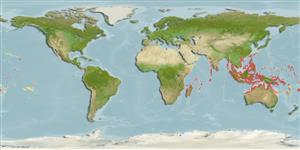>
Kurtiformes (Nurseryfishes, cardinalfishes.) >
Apogonidae (Cardinalfishes) > Apogoninae
Etymology: Taeniamia: Name from feminine Latin noun 'taenia' meaning ribbon or band; and feminine Greek noun 'Amia' meaning a fish, often used with cardinalfishes genera. Here as Taeniamia referring to the vertical wide bars and near vertical to curved narrow bars as lines on most of the species in this genus.
More on author: Cuvier.
Environment: milieu / climate zone / depth range / distribution range
Ecologia
marino associati a barriera corallina; distribuzione batimetrica 2 - 20 m (Ref. 90102). Tropical
Indo-West Pacific: eastern Indian Ocean and western Pacific.
Size / Peso / Age
Maturity: Lm ? range ? - ? cm
Max length : 9.5 cm TL maschio/sesso non determinato; (Ref. 90102)
Short description
Chiavi di identificazione | Morfologia | Morfometria
Spine dorsali (totale) : 7; Raggi dorsali molli (totale) : 9; Spine anali: 2; Raggi anali molli: 13 - 15. Diagnosis: Rays: dorsal VI + I,9; anal II,13-15; pectoral rays 14 (rarely 13 or 15). Gill rakers 5-6 + 15-17. Lateral-line scales 25+3-5. Median predorsal scales 5-7. Body depth 2.4-2.7 in SL; body width 2.3-2.6 in body depth; eye diameter 2.55-3.0 in head length; first dorsal spine 2.0-2.9 in second spine; second dorsal spine 2.3-2.9, and third dorsal spine 2.4-2.8 in head length; spine of second dorsal fin 2.3-2.8, and second anal spine 2.6-3.2 in head length; pelvic-fin length 4.5-5.15 and caudal-peduncle length 4.3-5.4 in SL; distance from insertion of pelvic spine to anal-fin origin 3.8-4.8 in SL. Basilingual teeth absent. Posterior preopercular edge completely serrate, or nearly so; ventral edge serrate on posterior half. Scaly sheath along anal-fin base poorly developed or absent (Ref. 54391).
Inhabits lagoon and fringing coral and rocky reefs with sand or rubble bottom in relatively clear water. Usually in aggregations, among branching corals, sometimes with its congeners (Ref. 36661, 48635, 54391).
Life cycle and mating behavior
Maturità | Riproduzione | Deposizione | Uova | Fecundity | Larve
Mouthbrooders (Ref. 240). Distinct pairing during courtship and spawning (Ref. 205).
Gon, O. and J.E. Randall, 2003. Revision of the Indo-Pacific cardinalfish genus Archamia (Perciformes: Apogonidae), with description of a new species. Indo-Pac. Fish. (35):49 p. (Ref. 54391)
IUCN Red List Status (Ref. 130435: Version 2024-2)
Threat to humans
Harmless
Human uses
Strumenti
Special reports
Download XML
Fonti Internet
Estimates based on models
Preferred temperature (Ref.
123201): 25.2 - 29.3, mean 28.5 °C (based on 2991 cells).
Phylogenetic diversity index (Ref.
82804): PD
50 = 0.5001 [Uniqueness, from 0.5 = low to 2.0 = high].
Bayesian length-weight: a=0.01445 (0.00680 - 0.03071), b=3.07 (2.89 - 3.25), in cm total length, based on LWR estimates for this (Sub)family-body shape (Ref.
93245).
Trophic level (Ref.
69278): 3.5 ±0.5 se; based on size and trophs of closest relatives
Resilienza (Ref.
120179): Alto, tempo minimo di raddoppiamento della popolazione meno di 15 mesi (Preliminary K or Fecundity.).
Fishing Vulnerability (Ref.
59153): Low vulnerability (10 of 100).
Nutrients (Ref.
124155): Calcium = 153 [76, 256] mg/100g; Iron = 1.02 [0.58, 1.80] mg/100g; Protein = 18.6 [17.5, 19.8] %; Omega3 = 0.124 [0.067, 0.225] g/100g; Selenium = 29.8 [14.6, 59.5] μg/100g; VitaminA = 58.5 [17.0, 206.3] μg/100g; Zinc = 1.8 [1.2, 2.7] mg/100g (wet weight);
